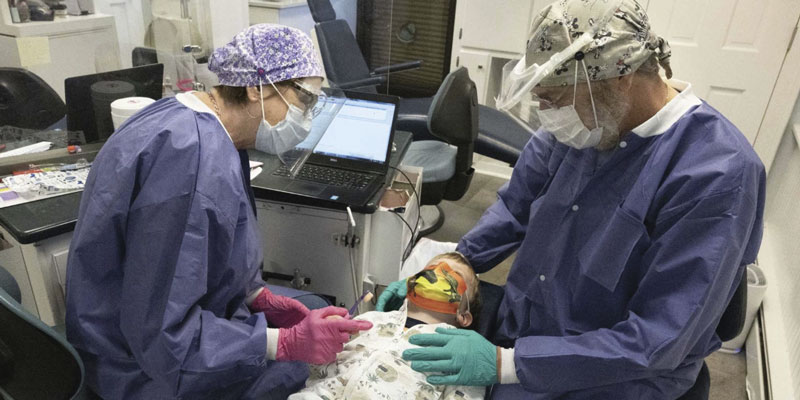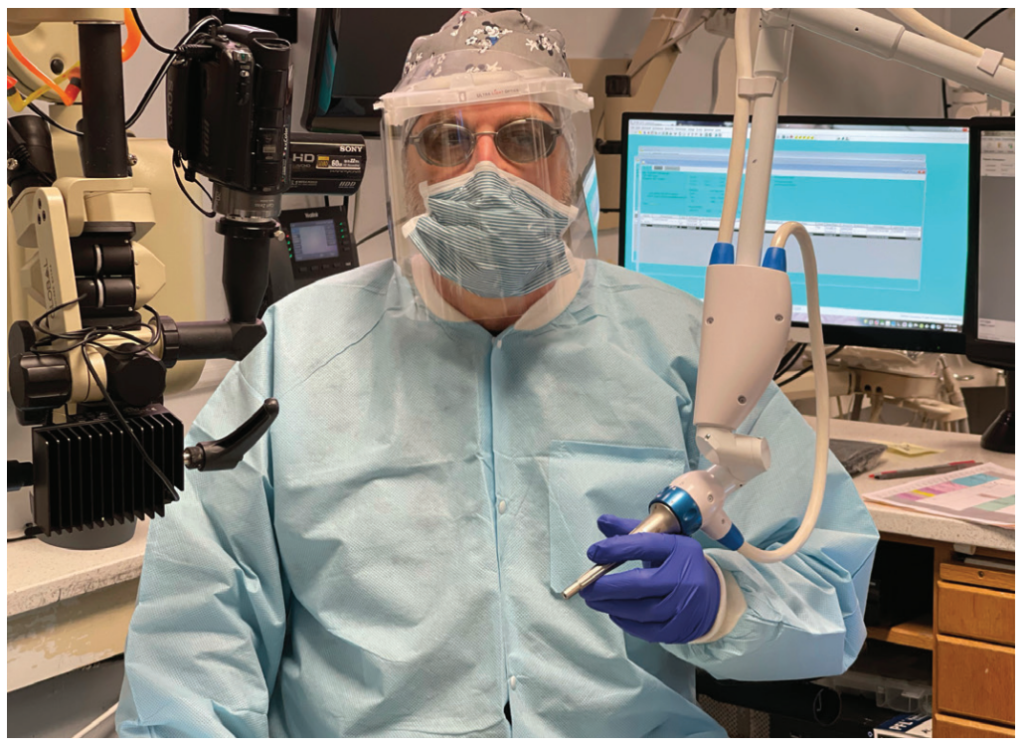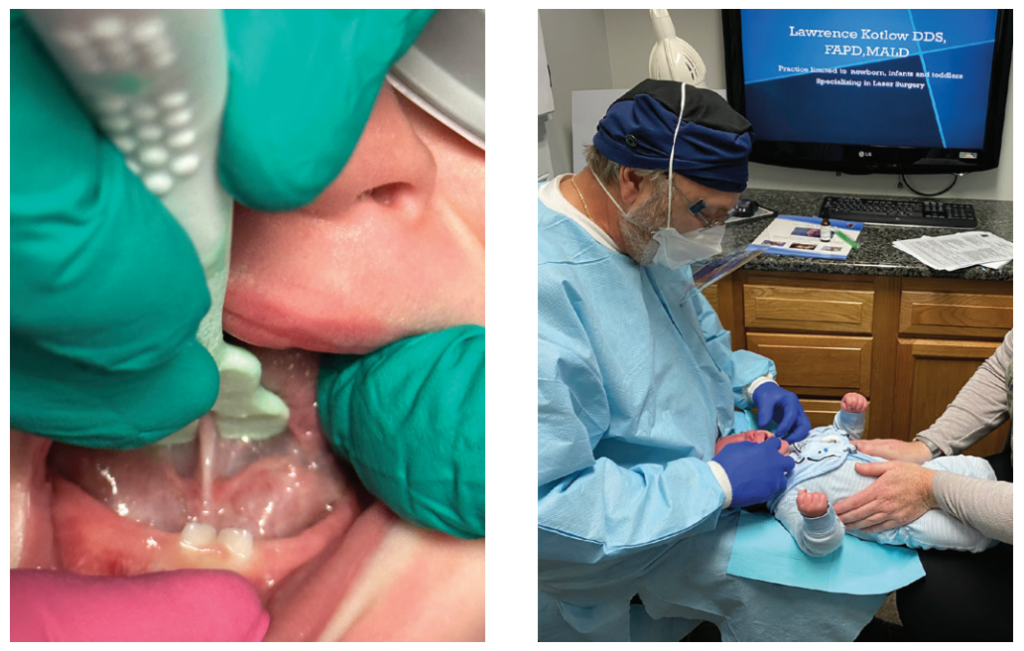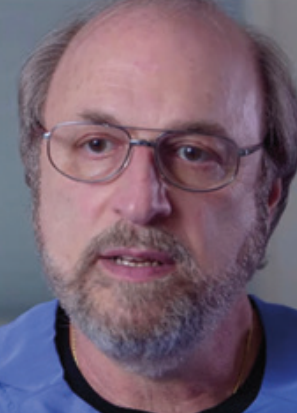Innovations in infant frenectomies
Dr. Lawrence Kotlow says that his Solea laser technology has made frenectomies less stressful, reduces bleeding, and is more efficient than using traditional scalpel methods.

Dr. Lawrence Kotlow discusses how laser technology has influenced his practice
Frenectomies are having a moment. While the number of restricted tethered tongue and lip ties has remained constant, 77% of pediatric dentists report seeing an increase in frenectomy referrals in the past five years.1
After graduating high school in 1965, I went into pharmacy school because I wanted to do something in the health profession, but I wasn’t going to get into pre-med or pre-dent with my high school grades. So, I worked hard in pharmacy, and at the end of 3 years, I had all the requirements for dental school fulfilled. I got into dental school without an undergrad degree.
In dental school, I always intended to go into pediatric dentistry from the get-go. There was no question. I spent my high school years as a counselor in day camps working with young children. I always liked working with children, but I didn’t want to be a pediatrician. As a dentist, I try to be accessible to parents, so I give them my personal cell phone. If you have a newborn baby, you don’t want to wait 24 hours to get a call back from your doctor. You want to call back as soon as you can, so I don’t have an exchange. I don’t have anybody to cover for me. I have me, myself, and my team, and we take care of all the emergency calls from parents.

When I graduated dental school, I would have older children coming in who had gone to speech therapy for three, four, five years. No one looked at their tongue as a potential source of their speech issues, even though it was attached to the tip of their jaw right behind the lower front teeth. So, I taught myself how to perform frenectomies. In those days, we’d use scalpels, and we had to use local anesthetics on everybody and suture everything. But you know what? We got good results.
Also in those days, I would see more patients with what we call nursing bottle syndrome, and all their front teeth would have decay. The only way we could save them would be by putting crowns on their front teeth. Now, if they had a tight upper lip tie, and we put the crowns on, the tissue wouldn’t heal right because it was always pulling it away, so we started doing the lip ties. And when their teeth came in, they came in perfectly straight. It was rewarding because we could see these results. That’s why I feel like these procedures are so important.
Creating awareness for a life-changing procedure
In 1979, I wrote the first article about how the upper lip tie can affect tooth decay and the upper front teeth. That took a lot of effort to get published because people were not in tune with what I was doing, and they were saying it can’t happen. But it does happen. And now a lot of people understand why.
Ultimately, what drives a parent to the office is their symptoms, or as I like to call them now, comorbidities — the baby’s and theirs — and how much it hurts. People want solutions that are proven to work, and I can demonstrate that frenectomies work. A lot of what we do is based on the fact that it works, that parents are happy, and that children develop normally. Parents who come back to me with their second or third or fourth child aren’t waiting around for a medical diagnosis. They come right to see me.
The biggest challenge to increasing awareness is getting medical professionals on board, so they see the value of frenectomies and start referring patients rather than discouraging them. I thought that once the physicians who were in practice 50 years ago stopped practicing, the new generation would see the results and understand the value. But that hasn’t happened yet. This knowledge has to get into medical schools. They have to understand how nursing works, and they have to understand that frenectomies are not a fad. Creating meaningful change is going to require getting into literature with peer-reviewed articles that they will accept and that they will publish.

Bringing relief to children and parents
Releasing restricted oral tissues can be a life-changing procedure for young patients and their parents. Here’s an example: It’s a Sunday night, I’m sitting watching football and I get a text message. It was a distraught mother whose baby was going to go under general anesthesia on Monday for an endoscopy because she had a distended belly. They’d run tons of genetic studies and could find nothing wrong with the child. So, she sent me some pictures, and I told her to cancel her appointment and see me the next day. The child’s lip and tongue were tied. We released it and in 24 hours, and all the symptoms were disappearing, giving the child and the mother significant relief and avoiding a more invasive procedure.
Over the years, technological advances, in particular the introduction of dental lasers, have transformed our ability to perform frenectomies. If we go back to when we used a scalpel to perform this procedure, we couldn’t do this on an infant because of the bleeding and difficulty to suture inside an infant’s mouth. Lasers have changed that.
In 2011, Convergent Dental came to me and said they’re developing a new 9.3-micron CO2 laser called the Solea® All-Tissue Dental Laser. And I told them I had five lasers and didn’t need another laser. But I listened to them, and a 1-hour conversation turned into 4 hours. I went to visit their facility in Massachusetts, and I worked with them to make sure the instrument would work on newborns and toddlers. Within a year, we had a laser that really changed everything. Because now I have an all-tissue CO2 laser, with which we see little to no bleeding, and in the vast majority of patients, we don’t have to suture. Plus, we can get children in and out quickly. When I use a laser, if by chance the infant or toddler was to move, and I hit another piece of tissue, it turns white for a second, and then I just rub it, and it disappears. If that happens with a scalpel, I’d be putting sutures in. Lasers are precise instruments that allow dentists to precisely release soft tissue.
The combination of education, awareness, and technology adoption has made this procedure so much more accessible. I’ve lectured to over 5,000 dentists in the last 20 years, and in the past, I had patients fly in from around the world for treatment. Now, there are people all over the world who are performing this procedure. So, I think dentists, especially those who are open to using lasers and not scissors or scalpels, have learned the proper techniques, and education is on the rise as they hear me and other dentists speak about this technology and this procedure.
A dentist who bought a practice contacted me. The prior dentist had a laser, and he asked what he needed to do to use it. I said, leave it in the box and take a course. The Academy of Laser Dentistry provides proficiency courses and exams that will teach you the basics. If they want to do frenectomies, take my course or some of the other courses that are given by educated dentists. And ask your laser provider about the training and clinical support they provide for frenectomies and other procedures that can be performed with the device.
There are so many things we’re doing today that we didn’t do 50 years ago. In pediatric dentistry, if you’re good at performing frenectomies, you’re going to get many referrals. But you have to be prepared to be available. If you can’t do this job efficiently and you’re telling patients you’re going to see them in a month, that doesn’t work because they and their baby are experiencing pain and discomfort. That means you have to change your practice to make sure you’re there for your patients when they need you.
 Dr. Lawrence Kotlow has been in private practice since 1974, serving the specialized needs of children. He is considered an expert in the world of restricted tethered oral tissue procedures (RTOTS), and is known throughout the country for his innovative techniques and lectures for some of the top dental societies and dental companies. Dr. Kotlow has lectured in Australia, Israel, Taiwan, Canada, England, France, and throughout the United States concerning pediatric dentistry and lasers, written over 35 articles, and authored chapters on pediatric dentistry and lasers for three laser textbooks. His 2016 book, SOS 4 TOTS: Exposing the Myths about Breastfeeding and Healing the Heartbreak to Make Breastfeeding a Joy, is a well-regarded resource for parents looking for information about how tongue and lip ties affect breastfeeding, dental development, and overall pediatric health. He completed board certification in the specialty of pediatric dentistry from the American Board of Pediatric Dentistry in 1980. He is one of only 18 dentists recognized by the Academy of Laser Dentistry to certify other dentists in standard proficiency to use lasers. Dr. Kotlow is a laser expert, having used many different lasers including erbium, diode, ND:YAG, and now Solea. Dr. Kotlow has been on the forefront of new technologies and continues to investigate and invest in any technology that will be of benefit to children. He attended the Albany College of Pharmacy, graduated from the SUNY Buffalo School of Dentistry, and completed his Pediatric Dental Residency at Cincinnati Children’s Hospital. Dr. Kotlow is a member of the American Dental Association, the New York State Dental Association, the International College of Dentists (Fellow), the Academy of Laser Dentistry (Achieved Mastership), the Third District Dental Society, the American Academy of Pediatric Dentistry (Fellow), the International Affiliation of Tongue-Tie Professionals, and the American Board of Pediatric Dentistry (Diplomate). Dr. Kotlow also became part of an exclusive group of dentists this year, when he was elected into the prestigious Pierre Fauchard Academy.
Dr. Lawrence Kotlow has been in private practice since 1974, serving the specialized needs of children. He is considered an expert in the world of restricted tethered oral tissue procedures (RTOTS), and is known throughout the country for his innovative techniques and lectures for some of the top dental societies and dental companies. Dr. Kotlow has lectured in Australia, Israel, Taiwan, Canada, England, France, and throughout the United States concerning pediatric dentistry and lasers, written over 35 articles, and authored chapters on pediatric dentistry and lasers for three laser textbooks. His 2016 book, SOS 4 TOTS: Exposing the Myths about Breastfeeding and Healing the Heartbreak to Make Breastfeeding a Joy, is a well-regarded resource for parents looking for information about how tongue and lip ties affect breastfeeding, dental development, and overall pediatric health. He completed board certification in the specialty of pediatric dentistry from the American Board of Pediatric Dentistry in 1980. He is one of only 18 dentists recognized by the Academy of Laser Dentistry to certify other dentists in standard proficiency to use lasers. Dr. Kotlow is a laser expert, having used many different lasers including erbium, diode, ND:YAG, and now Solea. Dr. Kotlow has been on the forefront of new technologies and continues to investigate and invest in any technology that will be of benefit to children. He attended the Albany College of Pharmacy, graduated from the SUNY Buffalo School of Dentistry, and completed his Pediatric Dental Residency at Cincinnati Children’s Hospital. Dr. Kotlow is a member of the American Dental Association, the New York State Dental Association, the International College of Dentists (Fellow), the Academy of Laser Dentistry (Achieved Mastership), the Third District Dental Society, the American Academy of Pediatric Dentistry (Fellow), the International Affiliation of Tongue-Tie Professionals, and the American Board of Pediatric Dentistry (Diplomate). Dr. Kotlow also became part of an exclusive group of dentists this year, when he was elected into the prestigious Pierre Fauchard Academy.
- Dhir S, Landau BP, Edemobi S, Meyer AK, Durr ML. Survey of Pediatric Otolaryngology Frenotomy Practice Patterns. 2022 Dec;132(12):2505-2512.
Using Solea laser technology brings innovation into the pediatric practice. Read more about that in Dr. Jenny Jackson’s article, “This is not a drill: tips to improve patient experience with laser technology”: https://pediatricdentalpractice.com/this-is-not-a-drill-tips-to-improve-patient-experience-with-laser-technology/.
